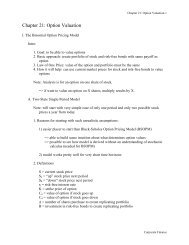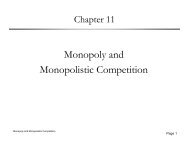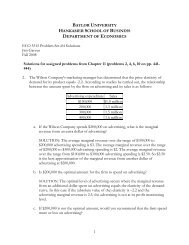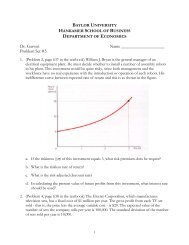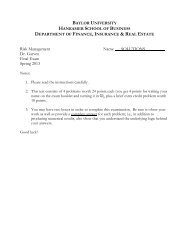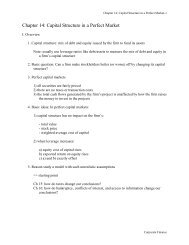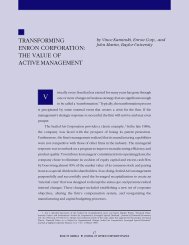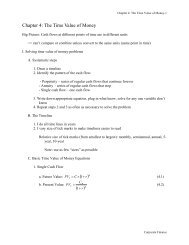Insurance Company Capital Structure Swaps and Shareholder Wealth
Insurance Company Capital Structure Swaps and Shareholder Wealth
Insurance Company Capital Structure Swaps and Shareholder Wealth
You also want an ePaper? Increase the reach of your titles
YUMPU automatically turns print PDFs into web optimized ePapers that Google loves.
Ej = Aj − Lj<br />
In Equation 4, E is value of equity, A is value of tangible assets <strong>and</strong> L is the present value of<br />
expected claims. The subscript j is either M (market value) or I (insider value). If the assets of<br />
the firm are investments in the market portfolio, they can be readily valued without dispute <strong>and</strong><br />
market values equal insider values. 6 We are left with Ej sensitive to only Lj. When the estimates<br />
of expected losses differ, the manager’s estimate of firm equity value is defined by Equation 5:<br />
EI = A − LI<br />
And the market value is defined by Equation 6:<br />
EM = A − LM<br />
In a competitive market regulated both by state insurance departments <strong>and</strong> the Securities<br />
<strong>and</strong> Exchange Commission, some might argue that differences between the insider value <strong>and</strong> the<br />
market value of expected losses should rarely exist. However, Weiss <strong>and</strong> Chung (2004) suggest<br />
that probability updating for losses may drive such differences. The 2003 restatement of reserves<br />
for asbestos exposure exemplifies revaluation of loss reserves across the industry. As firms realized<br />
that their previous estimates of asbestos exposure were incorrect, they re-stated the true expected<br />
loss related to asbestos. Prior to the completion of these reserve analyses, the market estimated<br />
the value of the losses higher than the firm. Differences between the insider’s estimate of loss<br />
variability <strong>and</strong> the market estimation of variability may exist in other instances. For example, the<br />
manager observes the details of the policy <strong>and</strong> thus may have a better estimate of the insureds’<br />
loss distributions. At the same time, the market can only estimate the policy characteristics under<br />
limited access to the underwriting files, prior loss experience, regulatory filings <strong>and</strong> ratings agency<br />
result of such an action, but the manager is acting based on his own beliefs <strong>and</strong> assumptions about the dynamics of<br />
the firm’s loss portfolio.<br />
6 If the insurer does not hold the market portfolio on the asset side, there may be additional opportunities for<br />
capital structure arbitrage that are not modeled here.<br />
11<br />
(4)<br />
(5)<br />
(6)



